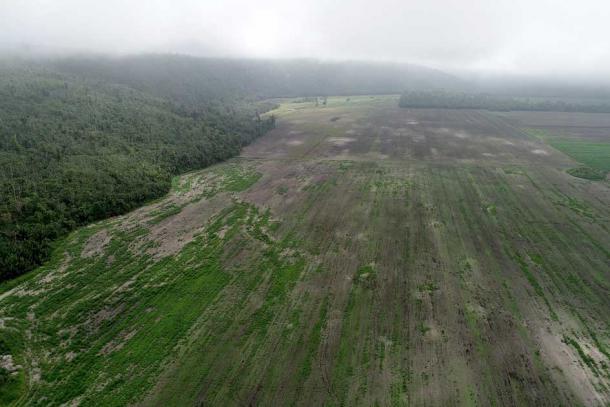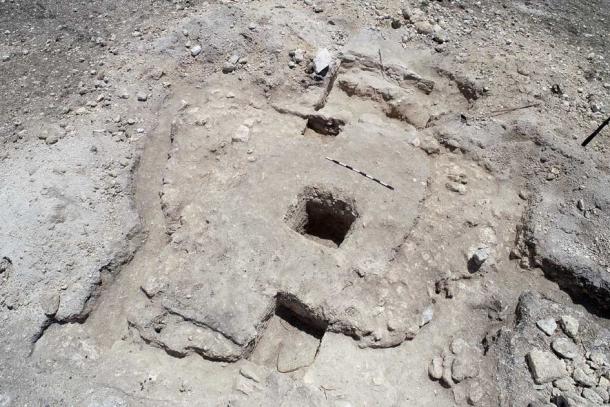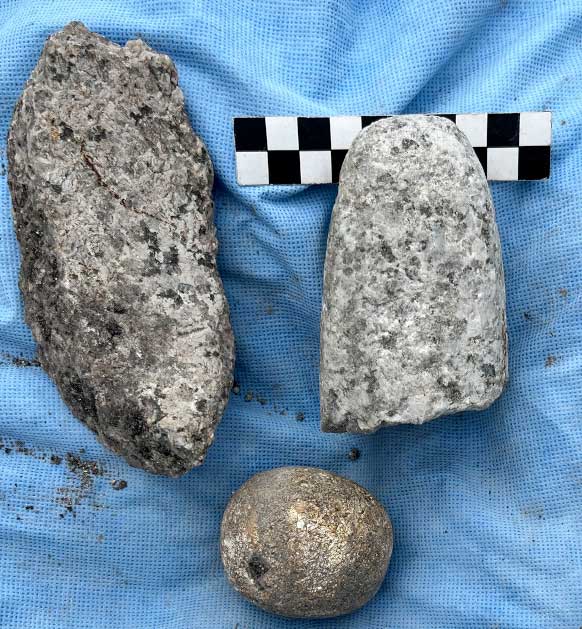
Excavations at Maya Settlement in Belize Tell Story of Maya Golden Age
Representatives of the Belize Institute of Archaeology have been working with graduate students from the University of Illinois Urbana-Champaign on a series of excavations in Central America. During a recent dig, the team of established and aspiring scholars was delighted to find a shallowly buried ancient Maya settlement, on a site that had long ago been converted into an agricultural field by a Mennonite farming community.
At the Spanish Lookout Mennonite community in Central Belize, the archaeologists and graduate students were given access to a large, open, heavily plowed field. They knew this was the perfect place to look for an ancient Maya settlement, since the upper part of the settlement ruins could be seen by the naked eye.
“White mounds, the remnants of these houses, pock the landscape as far as the eye can see, a stark reminder of what existed more than 1,000 years ago,” anthropology graduate students Rachel Gill and Yifan Wang wrote in a University of Illinois Urbana-Champaign press release announcing the unearthing of the Maya settlement in Belize. The white mounds were easily visible in aerial photographs, which are often used by archaeologists looking for hidden ruins to excavate.

Anthropology graduate students Rachel Gill and Yifan Wang are studying the remains of an ancient Maya settlement in Belize. This is an aerial photo of the archaeological site facing east. The white smudges are ancestral Maya mounds. (©2022 VOPA and Belize Institute of Archaeology, NICH / University of Illinois)
Plowing Didn’t Destroy Much of the Maya Settlement
While the plowing has caused some diminishment of the upper level of the ruins, a surprisingly large treasure of artifacts and structural elements have been recovered during the ongoing excavations. Especially revealing have been the ceramic sherds that were recovered in abundance, which the archaeologists used to date the site to the Maya Classical Period. This era lasted from 250 to 900 AD and is recognized as the Golden Age of the prosperous and powerful Maya Empire, which at its peak spread far and wide across the lands of modern-day southern Mexico and northern Central America.

Incised ceramic sherds excavated from the Maya settlement in Belize. (©2022 VOPA and Belize Institute of Archaeology, NICH / University of Illinois)
The researchers were able to narrow down the time frame of this particular Maya settlement to the 250 to 600 AD time frame, which is considered the Early Classic Period. This is when the Maya launched many of their most ambitious monumental construction projects, and it is also the time when the greatest cities of the Maya Empire were constructed.
Finding Out How the Maya Really Lived
The burial mounds excavated so far are distributed over an expansive landscape, and this has given the Belize-based archaeologists and their student partners new insights into the lives and lifestyles of the ancient Maya people.
“Standard residences have walls, plaster floors and a collection of domestic vessels that were used for cooking, serving and storage,” Gill and Wang wrote, detailing the inventory of their team’s discoveries. “We also found agricultural tools made of chert, a type of crystalline rock that resembles flint, and manos and metates, which were used to grind maize into flour.”
Most of the homes and other structures the team uncovered would have belonged to families of modest means. But there was one exception. On a large, raised mound built in the shape of a platform, they found the ruins of four elaborate structures surrounded by a private courtyard.
“It is clear that an elite family lived here,” the anthropology graduate students wrote. “This mound would have been secluded, sectioned off from the rest of the neighborhood, like the large house at the end of a cul-de-sac.”
In addition to the elite living complex, they found one other building with a most unique design. This structure was built from uniformly shaped stones and white limestone plaster, which were not the materials the Maya people used to build farmhouses.

An aerial photograph of what researchers believe is a community structure, like a church or recreation center, at the newly discovered Maya settlement in Belize, which is telling us more about this culture from a daily life perspective. (©2022 VOPA and Belize Institute of Archaeology, NICH/University of Illinois)
“We think we found some type of community building, perhaps for community events or ceremonies, similar to a modern church or recreation center where everyone was welcome,” Gill and Wang explained.
“Both the elite and non-elite families that lived in this neighborhood together may have invested in the construction of the community building amid the surrounding residences,” they continued. They concluded this because “the artifacts recovered from the community center were of better quality than those found in dwellings.”
To illustrate the latter observation, they singled out a cache of 15 stemmed points made from high-quality chert that was found in the structure’s ruins. These were of a type that the Maya made and used for ceremonial purposes only, specifically as an offering to the gods that would bring blessings to a new structure. The discovery of these items shows the entire community had an emotional investment in this particular building.

Grinding tools typical of ancestral Maya farmsteads found at the Belize settlement site included a metate fragment (left), a round stone (bottom) and a mano fragment (right). Metates and manos were used to grind maize. (©2022 VOPA and Belize Institute of Archaeology, NICH / University of Illinois)
Not Just a New Maya Settlement in Belize, but a Community
Rachel Gill and Yifan Wang emphasize the holistic nature of the newly discovered Maya settlement, which was expansive and densely populated and produced a wealth of artifacts and ruins that reveal the truth about how the Maya related to each other and how they lived on a daily basis.
- Caracol: The Most Remote and Magnificent Maya Ruins In Belize
- Maya Animation? Breathing Newfound Vitality into Ancient Maya Art
“As we stand at the crossroads of an ancient Maya neighborhood, if we close our eyes and let the present fade away, we can imagine the mundane realities of life in this exact spot nearly 2,000 years ago,” the anthropology graduate students wrote, inviting their readers along on a journey of the imagination. “The rustle of the leaves of the jungle above us, the scrape and clink of grinding maize, the smell of cooking maize and beans, or the chatter of a neighbor borrowing a tool or asking about the weather.”
The Maya Empire has been gone for many centuries. But it will be remembered and celebrated far into the future, for its grand monuments, its sophisticated culture, its complex metaphysics, and for its capacity to live in ecological balance and in harmony with the surrounding environment.
Top image: Aerial view of the elite platform and the 15 stemmed macroblades found in a cache at the Maya settlement in Belize. Source: ©2022 VOPA and Belize Institute of Archaeology, NICH / University of Illinois
By Nathan Falde
















Comments
In keeping with the silly narrative, “Both the elite and non-elite families that lived in this neighborhood together”. Elite/non-elite, back then? Break it down for me. But kudos to the Mennonites!
Nobody gets paid to tell the truth.